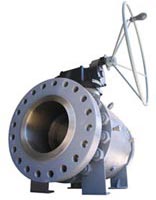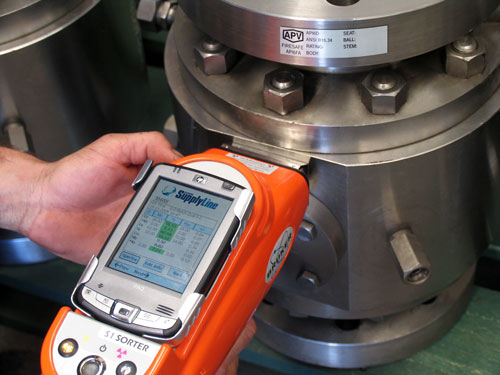Valve Materials – Suitability, Performance & Applications

- Stainless Steel Valves 304/304L/CF8/CF3
- Stainless Steel Valves 316/316L/CF8M/CF3M
- Duplex Steel Valves F51/F53/F55/S31803/CD3MN/CE3MN/2205/4A/5A/6A
- Exotic Alloy Valves A20/Monel
- Low Temp Carbon Steel Valves LCC/LCB/LF2
- Standard Carbon Steel Valves WCB/WCC/A105
- Chrome Moly Steel Valves F11/F22/F5/WC5/WC9/WC6
Major Categories of Common Valve Materials
FORGED |
CAST |
|---|---|
| CARBON STEEL | |
| ASTM A105N | ASTM A216 WCB/WCC |
| ASTM A350 LF2 | ASTM A352 LCB/LCC |
| ALLOY STEEL | |
| ASTM A350 LF3 | ASTM A352 LC3 |
| ASTM A182 F5A/F5 | ASTM A217 C5 |
| ASTM A182 F9 | ASTM A217 C12 |
| ASTM A182 F11 | ASTM A217 WC6 |
| ASTM A182 F22 | ASTM A217 WC9 |
| ASTM A182 F91 | ASTM A217 C12A |
| AUSTENITIC STAINLESS STEEL | |
| ASTM A182 F304/F304L | ASTM A351 CF8/CF3 |
| ASTM A182 F316/F316L | ASTM A351 CF8M/CF3M |
| ASTM A182 F347 | ASTM A351 CF8C |
| ASTM A182 F321 | |
| ASTM A182 F44 (6MO) | ASTM CK3MCuN |
| ASTM A182 F20* (ALLOY 20) | ASTM A351 CN7M |
| FERRITIC-AUSTENITIC STAINLESS STEEL | |
| ASTM A182 F51 – UNS S31803 (DUPLEX S.S.) | A995† GR.4A/A351 CD3MN |
| ASTM A182 F53 – UNS S32750 (SUPER DUPLEX S.S.) | A995† GR.5A/CE3MN* |
| ASTM A182 F55 – UNS S32760 (SUPER DUPLEX S.S.) | A995† GR.6A/CD3MWCuN |
| NICKEL ALLOY | |
| INCONEL 825 – UNS N08825 ASTM B564-N08825 | A484 CU 5MCuC* |
| INCONEL 600 – UNS N06600 ASTM B564-N06600 | A494 CY40* |
| INCONEL 625 – UNS N06625 ASTM B564-N06625 | A494 CW6MC* |
| MONEL 400 – UNS N04400 ASTM B564-N04400 | A494 M35-1 |
| TITANIUM | |
| ASTM B381 GR.F2 | ASTM B367 GR.C2 |
| ASTM B381 GR.F3 | ASTM B367 GR.C3 |
† A990 is optionally superseded by A995. A890 is now only used for non pressure retaining parts CD3MN, CD4MCu, CD3MWCuN have been deleted from A351 and added to A995 and may be supplied in compliance with grades 4A, 1B and 5A respectively
*No longer referenced in ASME B16.34-2009

in-house PMI facilities for Alloy grade verification.
Click here for more information on all our testing capabilities.
MATERIALS USED IN VALVE CONSTRUCTION
The following is a general review of common valve materials used in general industrial, commercial and process valve construction.
Go to the Technical section of our website for a more detailed overview on the full range of valve body and trim materials used in the construction of special service valves for oil & gas, mining, petrochemical and critical service process control applications.
Aluminum – A non-ferrous metal, very lightweight, approximately one-third the weight of steel. Aluminum exhibits excellent atmospheric corrosion resistance, but can be very reactive with other metals. In valves, aluminum is mainly used as for exterior components such as a hand wheels or identification tags.
Copper – Among the most important properties of wrought copper materials is their thermal and electrical conductivity, corrosion resistance, wear resistance, and ductility. Wrought copper performs well in high temperature applications and is easily joined by soldering or brazing. Wrought copper is generally only used for fittings.
Bronze – One of the first alloys developed in the Bronze Age is generally accepted as the industry standard for pressure rated bronze valves and fittings. Bronze has a higher strength than pure copper, is easily cast, has improved machinability, and is very easily joined by soldering or brazing. Bronze is very resistant to pitting corrosion, with general resistance to a wide range of chemicals.
Silicone Bronze – Has the ductility of copper but much more strength. Silicon bronze has equal or greater corrosion resistance to that of copper. Commonly used as a stem material in pressure-rated valves, silicon bronze has greater resistance to stress corrosion cracking than common brasses.
Aluminum Bronze – The most widely accepted disc material used in butterfly valves, aluminum bronze is heat treatable and has the strength of steel. Formation of an aluminum oxide layer on exposed surfaces makes this metal very corrosion resistant. Not recommended for high pH wet systems.
Brass – Generally good corrosion resistance. Susceptible to de-zincification in specific applications; excellent machinability. Primary uses for wrought brass are for ball valve stems and balls, and iron valve stems. A forging grade of brass is used in commercial ball valve bodies and end pieces.
Gray Iron – An alloy of iron, carbon and silicon; easily cast; good pressure tightness in the as-cast condition. Gray iron has excellent dampening properties and is easily machined. It is the standard material for bodies and bonnets of Class 125 iron body valves. Gray iron has corrosion resistance that is improved over steel in certain environments.
Ductile Iron – Has composition similar to gray iron. Special treatment modifies metallurgical structure, which yields higher mechanical properties; some grades are heat treated to improve ductility. Ductile iron has the strength properties of steel using similar casting techniques to that of gray iron and is used for class 250 (as well as class 125 in larger sizes).
Carbon Steel – Very good mechanical properties; good resistance to stress corrosion and sulfides. Carbon steel has high and low temperature strength, is very tough and has excellent fatigue strength. Mainly used in gate, globe, and check valves for applications up to 454ºC, and in one-, two-, and three-piece ball valves. Can be forged or cast, with forgings being superior especially for larges sizes in very high classes.
3% Nickel Iron – Improved corrosion resistance over gray and ductile iron. Higher temperature as well as corrosion resistance and mechanical properties. Very resistant to oxidising atmospheres.
Nickel-Plated Ductile Iron – Nickel coatings have received wide acceptance for use in chemical processing. These coatings have very high tensile strength, 50 to 225 ksi. To some extent, the hardness of a material is indicative of its resistance to abrasion and wear characteristics. Nickel plating is widely specified as a disc coating for butterfly valves. For industrial and petroleum ball valves, superior electroless nickel plating (ENP) is used in carbon steel valve components and is in fact superior to stainless steel in hardness but with similar corrosion properties.
400 Series Stainless Steel – An alloy of iron, carbon, and chromium. This stainless is normally magnetic due to its martensitic structure and iron-content. 400 series stainless steel is resistant to high temperature oxidation and has improved physical and mechanical properties over carbon steel. Most 400 series stainless steels are heat-treatable. The most common applications in valves are, for stem material in butterfly valves, and trim components such as seat, backseat bushings, discs, wedges etc. in cast steel gate, globe and check valves.
316 Stainless Steel – An alloy of iron, carbon, nickel, and chromium. A non-magnetic stainless steel with more ductility than 400 series SS. Austenitic in structure, 316 stainless steel has very good corrosion resistance to a wide range of environments, is not susceptible to stress corrosion cracking (however it is not suitable for higher levels of H2S typically found in wellhead applications) and is not affected by heat treatment. Very commonly used in valve body and/or trim material.
17-4 PH Stainless Steel – Is a martensitic precipitation/age hardened stainless steel offering high strength and hardness. 17.4 PH withstands corrosive attack better than any of the 400 series stainless steels and in most conditions its corrosion resistance closely approaches that of 300 series stainless steel. 17.4 PH is primarily used as a stem material for butterfly and ball valves as well as any valve application requiring a superior strength stem.
Alloy 20Cb-3 – This alloy has higher amounts of nickel and chromium than 300 series stainless steel and with the addition of columbium, this alloy retards stress corrosion cracking and has improved resistance to sulfuric acid. Alloy 20 is widely used in all phases of chemical processing.
Monel – Is a nickel-copper alloy used primarily as interior trim on all types of valves. One of the most specified materials for corrosion resistance to sea and salt water. Monel is also very resistant to strong caustic solutions.
Stellite – Cobalt base alloy, one of the best all-purpose hard facing alloys. Very resistant to heat, abrasion, corrosion, impact, galling, oxidation, thermal shock and erosion. Stellite takes a high polish and is used in steel valve seat rings. Normally applied with transfer plasma-arc; Stellite hardness is not affected by heat treatment.
Hastelloy C – A high nickel-chromium molybdenum alloy, which has outstanding resistance to a wide variety of chemical process environments including strong oxidisers such as wet chlorine, chlorine gas, and ferric chloride. Hastelloy C is also resistant to nitric, hydrochloric, and sulfuric acids at moderate temperatures.
CROSS REFERENCE CHARTS & VALVE MATERIAL REFERENCES
For a cross references table of ASTM/ANSI specifications covering equivalent materials used for valves, flanges & fittings: click here
For technical references and cross reference information on stainless, duplex, chrome-moly and Alloy steel used in valves & piping systems in the petrochemical and refining: click here
If we don’t have the valve in stock we can source it from our overseas network of stockists and very short lead time specialty manufacturers. We can even supply exotic grades like Nickel, Super Duplex F55 and Monel (ASTM A494 M35-1) Cd4M-Cu, Hastelloy C (ASTM A-494 CW12MW), 317 (C8G8M) in short lead time.
For other ANSI, ASME, ISO, API, valve related technical cross references relating to pressure, temperature, application, suitability, equivalents, valve body & trim materials, valve manufacturing & test standards, etc., go to the technical section of this website.
We stock valves in A105, LF2, 304, 304L, 316, 316L, F51, CF8, CF8M, CF8C, LF3, WC5, WC6, WC9, F11, F5, F22, Bronze, Iron, etc. in Ball, Butterfly, Check, Control, Gate, Globe, Needle, Parallel slide, Plug, etc. Valves are manufactured to API600, API602, API603, API6A, API6D, BS1868 and numerous other standards.
Disclaimer: The information in this site is to be used as a guide only, always refer to relevant standards prior to ordering.

